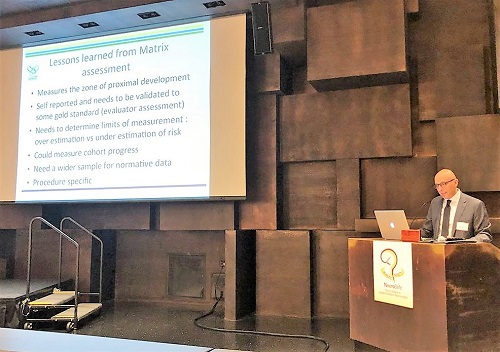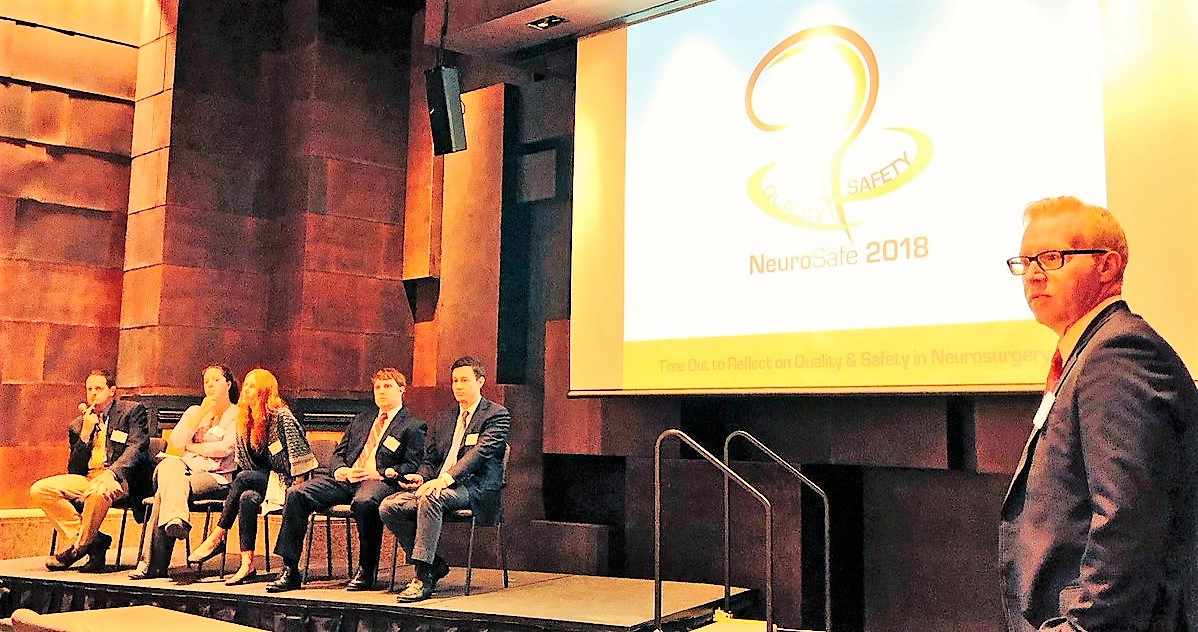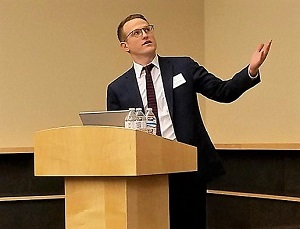NeuroSafe 2018 wraps up strongly, demonstrates “clear commitment” to neurosurgical safety and quality

The second and last day of NeuroSafe 2018, presented by the U of M’s Department of Neurosurgery, was held, August 3, at the university’s McNamara Alumni Center. This unique symposium brought together neurosurgeons, scientists, residents and nursing professionals from throughout North America to learn the latest about improving neurosurgical quality and safety.
Faculty members Matthew Hunt, MD; and Daniel Guillaume, MD, MS; along with Director of Clinic Operations and Faculty Practice/Department Administrator Barb Daiker, RN, PhD; and Administrative Supervisor Claire Graham, planned NeuroSafe 2018, with support from the U’s Department of Continuing Education.
The symposium – the only one of its kind – featured numerous keynote and abstract presentations focused on efforts to improve the care of neurosurgical patients. One such example was the keynote presentation by Ahmed M.T. Raslan (pictured above right), MD, of Oregon Health and Science University in Portland, titled Balancing Operative Efficiency and Surgical Education in Value-driven Healthcare.
Raslan’s keynote was following by a series of abstract presentations about quality and safety improvement projects:
- Decreasing No-show Rates to Pediatric Neurosurgery Outpatient Clinic – Back to Basics. Jeffrey S. Raskin, MD, MS
- Is Institutional Case Volume a Determinant of Practice of Safe Overlapping Surgery? Results from a Multi-institutional Survey and an Administrative Database, Mohamad Bydon, MD
- The Mental Health of Resident and Faculty Surgeons: A New Era of Burnout, David Darrow*, MD, MPH
- What They Don’t Teach You in Medical School – An Educational Program Enhancing Neurosurgical Resident Leadership and Wellness, Megan M. Jack, MD, PhD
- Pathway for Omitting ICU Level of Care Following Craniotomy for Resection of Supratentorial Brain Tumors, Chiari Decompression, and Microvascular Decompression Surgery, Jennifer A. Viner, CNRN, MS, NP
- Improving the Mortality Index by Capturing Patient Acuity through Interprofessional Real-time Documentation Improvement in a Single Hospital System, Chelsea R. Horwood, MD, MPH
- Utility of Multidisciplinary Simulation Education in Improving Care of Patients with Middle Cerebral Artery Syndrome, Mairaj Tariq Sami, MD, MS
- Neurosurgery Surgical Site Infection: One year of Control Data from a DMAIC Project, Charles R. Watts, MD, PhD.
New in 2018, a resident-submitted abstract was featured as one of the keynote presentations. The inaugural winner was David Dornbos, III, MD, of Ohio State University. He spoke about the Impact of Malnutrition on Expected Length of Stay and Mortality Metrics. His study on mortality risk found 23 percent of patients with first-time ventricular shunts had undiagnosed malnutrition (low albumin) and that malnutrition alone doubled hospital stay length. It became a key factor to check with incoming patients.
A series of abstract presentations followed Dornbos’ keynote:
- Is Institutional Case Volume a Determinant of Practice of Safe Overlapping Surgery? Results from a Multi-institutional Survey and an Administrative Database, Mohamad Bydon, MD
- Topical Vancomycin Powder Use Reduces the Incidence of Surgical Site Infections Following Craniotomy, Bledi C. Brahimaj, MD, and Ryan Khanna, MD
- Improving the Mortality Index by Capturing Patient Acuity through Interprofessional Real-time Documentation Improvement in a Single Hospital System, Chelsea R. Horwood, MD, MPH
- Life Beyond Residency: Are We Fully Optimizing Resident Education, Phillip D. Hylton, MD

Guillaume moderated a panel discussion following this round of abstract presentations. Panelists (pictured left to right) included Gerald A. Grant, MD, FAANS; Tammy B. Harmon, RN, BSN, CCRN; Jennifer Viner, CCRN, MS, NP; Dr. Dornbos; and Oren Gottfried, MD, FAANS. They discussed, Improving the Quality of Care: Beyond Metrics,and took questions from the audience.
TOPIC: What, besides data, do you need to improve quality?
- Viner: “A multidisciplinary team, including clinic staff, nurses, residents, etc.”
- Harmon: “You need people to be willing to see every patient as a person.”
- Dornbos: “Being able to have something tangible that comes from it. For example, residents at Ohio State University developed a protocol concerning whether stroke patients should receive a thrombectomy [mechanical removal of the clot that caused the stroke]. It took some of the guesswork out and we saw some patient improvement.”
- Gottfried: “Knowing your data, but not getting overwhelmed by it. You should create meaningful goals and follow patients over longer periods of time.”
- Grant: “With every case, take an opportunity to debrief and improve. It provides fuel for the future.”
TOPIC: What do you do to create a culture of quality and safety?
- Dornbos: “We have a Quality and Safety resident committee and each program has one resident representative. It helps start more collaborative efforts with other departments.”
- Viner: “At University of California San Francisco, we offer grant programs for improvement projects. In addition, residents have a quality and safety project that they complete every year.”
- Harmon: “Kansas University Neurosurgery has a diverse quality committee; all members are involved in more than one quality initiative.”
- Grant: “Leadership presence is really important.”
TOPIC: It's 2028. What does neurosurgical care look like in the United States in terms of quality and safety?
- Viner: “There will be more outpatient procedures. Surgery will be less invasive. The use of telemedicine will increase.”
- Dornbos: “Healthcare will consolidate into bigger centers. There will be more regimentation of post-op care.”
- Gottfried: “Our inclination to do a procedure will be held to a stricter standard. We’ll have more predictable outcomes and more data upon which to base decisions.”
- Harmon: “My role will be expanded across the country to help patients stay at home. There will be increased communication across hospital departments.”
- Grant: “More medical care will be based in your phone. Robots will flourish. Outcomes will matter as they will drive reimbursement far more.”
Following the panel, Dr. Bydon, who is with the Mayo Clinic College of Medicine, presented his keynote, Payment Reform in a Changing Healthcare Environment. He was followed by David W. Polly, Jr., MD, of the University of Minnesota Department of Orthopaedic Surgery, who walked the NeuroSafe 2018 audience through his presentation, Improving Complex Spine Care – Right Diagnosis, Right Treatment, Right Technical Execution.

U of M Neurosurgery Resident David Darrow, MD, MPH, discussed the impact of physician burnout
The afternoon finished with another round of abstract presentations:
- On Reporting Efforts at Process, Quality and Safety Improvement, Stephen J. Haines, MD, FACS
- Use of Physician Performance Platform to Quantify Effects of Durotomy Complications, Adam A. Khan*, MD
- Risk Assessment Modeling of Venous Thromboembolic Events in a Neurosurgery Population, David Dornbos III, MD
- The Mental Health of Resident and Faculty Surgeons: A New Era of Burnout, David Darrow*, MD, MPH.
As Guillaume and Hunt summarized the second and final day of the symposium for attendees, Hunt noted that NeuroSafe 2018 was, “Our best conference yet. The quality of the speakers and engagement of the neurosurgical community in the symposium makes clear the commitment of the profession to the quality and safety of our work.”
Stay tuned. NeuroSafe 2019 is coming.
*University of Minnesota neurosurgical resident



